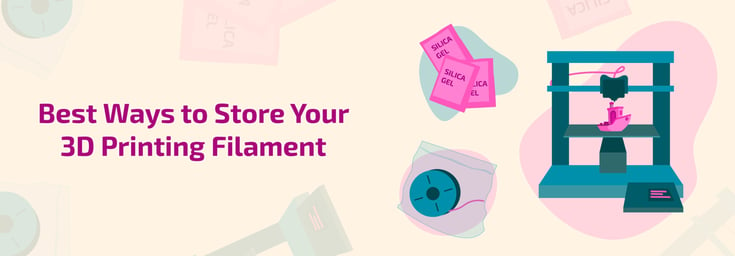Share this
Best Ways To Store Your 3D Printing Filament
by 3devo on Aug 13, 2021 11:35:00 AM
Moisture and humidity. These words send shivers down the spines of 3D printing filament worldwide. The very mention of it could mean your 3D models look more like The Walking Dead as each day passes. And yes, images of people leaving their filament out in the open, exposed to the elements, rotates in our minds. Keeping your filament dry results in high 3D print quality, increased accuracy, and many other benefits. In this article, we’ll be giving you some of the best ways to store your 3D printing filament.
How should I protect my filament?
It’s a very understandable question. After all, it’s plastic and shouldn’t be able to absorb water. However, most thermoplastics used in 3D printing are hygroscopic, so they absorb water from the air if left unprotected. This means that simply leaving your filaments out in the open can result in poor-quality prints.
The resulting effects on your filament aren’t pretty either, as here are some of the things that can happen to your filament once it absorbs moisture:
- Increased brittleness
- Filament degradation
- Diameter augmentation
- Filament bubbling / hissing steam at the hot-end
- Higher temperature is needed for extrusion
- Broken filament
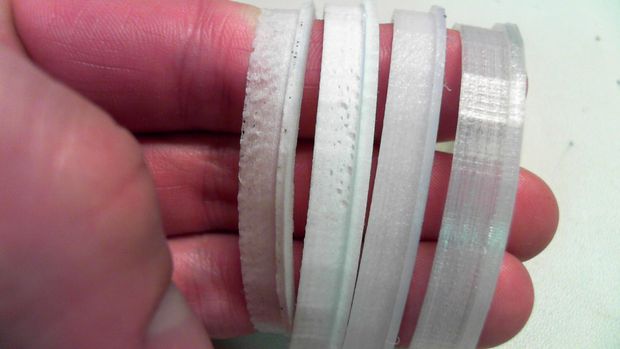 Nylon filament was harmed during this shot.
Nylon filament was harmed during this shot.
Some filament types are affected worse than others; for example, nylons are bad as they can absorb moisture after just 18 hours when out in the open. PVA is even worse, as it is used for support structures whereby afterward, it can dissolve in water. PLA and ABS can also absorb moisture (PLA more than ABS). Not only can your filament be affected, but your 3D printer too, as “swollen PLA filament can jam up the printer’s hot end and even require it to be replaced,” Clinton Freeman, RepRage.
1. Vacuum Bags
You could buy an expensive plastic casing for your individual spools, build an anti-humidity box on your roof to protect your filament from moisture, or you can buy a regular vacuum-sealed bag. You know, the ones you see on infomercials to keep all your winter clothes in order to save space in your home. Why use vacuum-sealed bags? Well, they keep all types of moisture, odors, mildew, and bugs away from your precious filament.
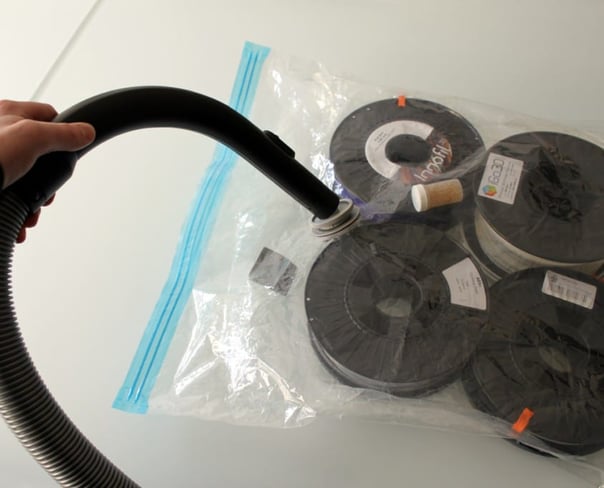
Remember: these aren’t Ziploc bags (bags that you simply seal at the top), as those don’t always get out all of the moisture. Try buying bags that have an opening for your vacuum cleaner to make sure all that life-saving oxygen is removed from the bag.
2. Silica Gel – Not Just For Shoes
Silica gel packs must become your best friend if you're using PLA filament. They might even come included when you buy some new filament, so you’re going to want to hold onto those. Why? Well, as mentioned above, PLA absorbs much more water than ABS. Don’t get me wrong, though; both still absorb water, so use these packs for both ABS and PLA.
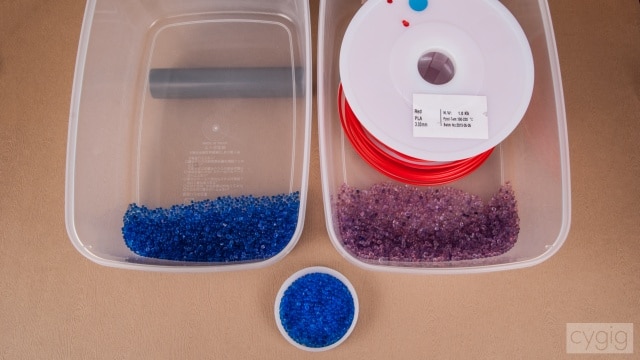 Blue means dry, purple, not so much. (Via forums.vr-zone.com)
Blue means dry, purple, not so much. (Via forums.vr-zone.com)
Silica gel packs come in different shapes and sizes; some can be reused if you dry them in an oven. However, these and other packs like these aren’t always the best, as you can’t tell when they have become saturated. If you want to get serious about drying out your filament, silica gel packs with moisture saturation indicators might be a better bet. These change color from yellow/orange to green or blue (depending on ambient moisture level). Simply place the gel packs into sealable Ziploc bags, Tupperware, or anything else that won’t let air get inside.
In the end, though, keeping your filament dry using silica gel is a neat and easy method for keeping your filament dry. Many people always ask if rice is a suitable replacement. It’s not bad, but it’s definitely not as good as using silica gel packs.
3. Use Your Filament
It’s great that filament comes in all different types and sizes. However, keeping too many and forgetting to use all of it, or simply not using the ones you have, is not the best idea if the filament is kept in an open area for long periods of time.
Be careful; keeping filament for over 12 months can lead to moisture absorption, depending on the filament. The best thing to do would be to buy only what you need and make sure to use it all within a few weeks/months.
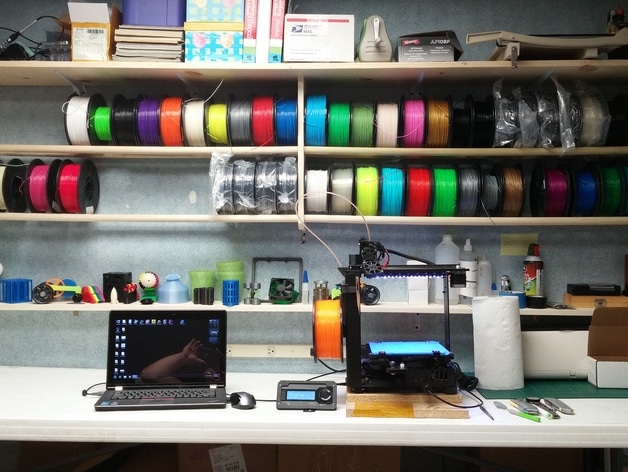 With great filament comes great responsibility. (Via Thingiverse)
With great filament comes great responsibility. (Via Thingiverse)
Ignite Innovation with Our Filament Maker!
Fuel your product with creativity and breakthroughs! Embrace the power of our Filament Maker to revolutionize your designs. Unleash endless possibilities and bring innovation to life. Get started now!
4. Bonus Tips:
- Use litmus strips in order to indicate humidity – a quick way instead of using color-changing desiccants.
- Always remove your filament when you have finished printing
- You can always 3D print your own spool holder to protect the filament from moisture
- Make your own “dry box” from various sources on the internet
- Dehumidifiers work well – plug it in overnight when it says “wet,” and you should be good to go again
You can’t make an omelet without cracking a few eggs, but 3D printing isn’t your typical breakfast, and using low-quality filament shouldn’t be an excuse for an average 3D print job. The tips used above, whether used on their own or combined with others on the list, will help you produce amazing, high-quality 3D prints. Some may sound a little extreme, but in the end, it will help save time, money, and tables from being flipped in frustration. You could even produce your own filament whenever you need or want to, but remember that your filament is precious. If you look after it, it will look after your 3D printing. Do you have any extra tips that we forgot to mention? Let us know in the comments section below.
Conclusion:
In conclusion, proper storage and protection of your 3D printing filament are essential for achieving high-quality prints and ensuring the longevity of your filament. Moisture and humidity can wreak havoc on the filament, leading to issues like increased brittleness, degradation, and diameter augmentation, affecting both the filament and your 3D printer.
To safeguard your filament, consider using vacuum-sealed bags to keep moisture, odors, and bugs at bay. Silica gel packs can be a valuable ally, especially for PLA filament, which is more prone to water absorption. These packs help absorb excess moisture and can be reused after drying in an oven.
Another vital tip is to use your filament promptly and avoid hoarding excessive quantities in open areas for extended periods. Filament can absorb moisture over time, affecting its printing quality.
By following these practical tips and incorporating other methods like using litmus strips, 3D printing spool holders, or dehumidifiers, you can maintain the optimal condition of your filament and achieve remarkable, high-quality 3D prints.
Remember, taking good care of your filament translates to excellent 3D printing results, saving you time, money, and potential frustration. Embrace these practices, and your filament will repay you with outstanding performance in your 3D printing endeavors.
Level up Your 3D Prints with Our Polymer Dryer!
Defeat filament moisture like a pro. Elevate your 3D printing game with our Polymer Dryer. Get it now!
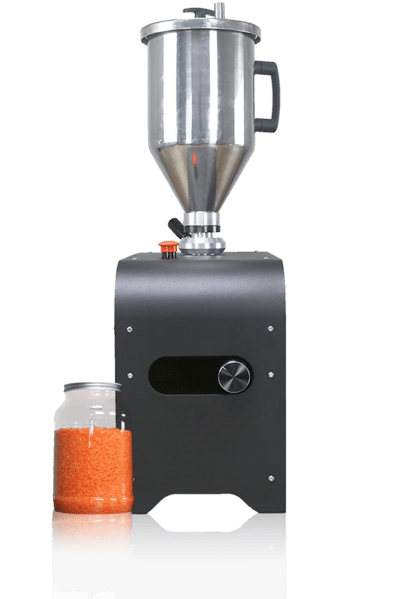
Share this
- November 2025 (1)
- October 2025 (1)
- March 2025 (1)
- January 2025 (1)
- December 2024 (2)
- November 2024 (2)
- October 2024 (4)
- September 2024 (2)
- August 2024 (3)
- July 2024 (6)
- June 2024 (3)
- May 2024 (2)
- April 2024 (1)
- March 2024 (1)
- January 2024 (1)
- November 2023 (2)
- October 2023 (5)
- September 2023 (2)
- August 2023 (1)
- July 2023 (1)
- May 2023 (1)
- December 2022 (2)
- June 2022 (1)
- May 2022 (2)
- April 2022 (2)
- March 2022 (6)
- February 2022 (2)
- January 2022 (3)
- December 2021 (3)
- November 2021 (3)
- October 2021 (2)
- September 2021 (3)
- August 2021 (3)
- July 2021 (2)
- June 2021 (1)
- March 2021 (1)
- October 2020 (1)
- June 2020 (1)
- May 2020 (1)
- April 2020 (4)
- November 2019 (1)
- July 2019 (2)
- June 2019 (1)
- May 2019 (1)
- March 2019 (1)
- November 2018 (1)
- September 2018 (1)
- January 2018 (1)
- October 2017 (1)
- September 2017 (1)
- July 2017 (1)
- June 2017 (1)
- May 2017 (1)
- January 2017 (1)
- December 2016 (3)
- November 2016 (2)
- October 2016 (1)
- May 2016 (2)
- August 2015 (2)
- July 2015 (1)
